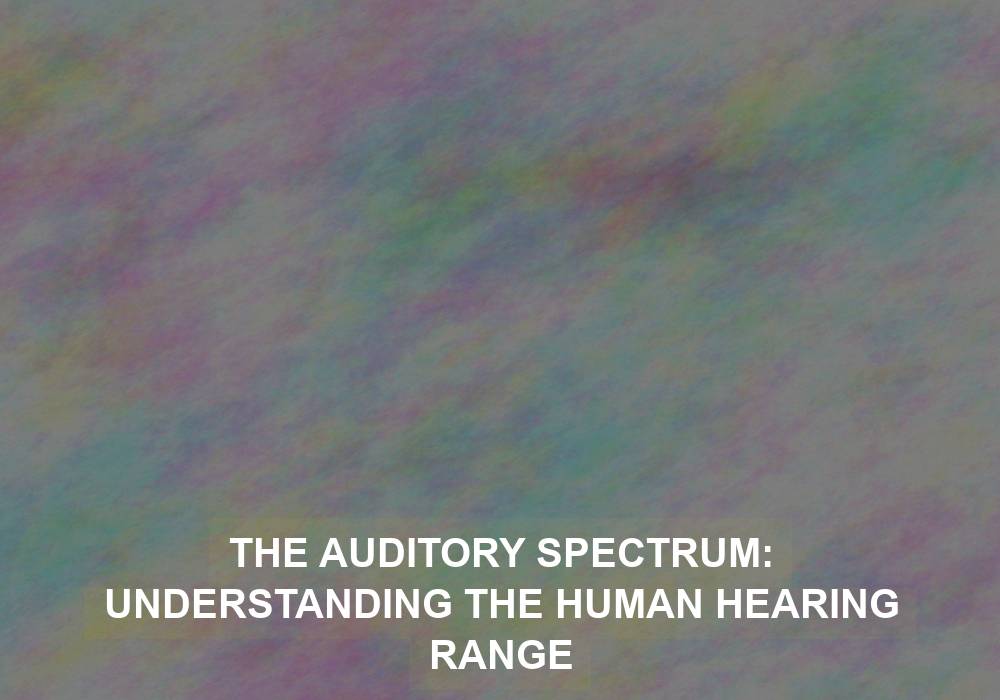The human hearing range is an intriguing aspect of our auditory system that allows us to perceive sound. By delving into the different frequencies and levels within this spectrum, we can gain valuable insights into how we experience and interact with sound in our daily lives.
The Basics of Sound and Frequency
Sound, as we know it, is a form of energy that travels through various mediums, such as air or water, in the form of waves. These waves consist of compressions and rarefactions, which create vibrations that our ears can detect. Frequency, on the other hand, refers to the number of cycles or vibrations a sound wave completes in a specific unit of time. It is typically measured in hertz (Hz).
The Human Hearing Range
Though humans cannot hear all frequencies, we possess an impressive range of audible sounds. The average human hearing range is generally considered to be between 20 Hz and 20,000 Hz. However, it is important to note that individual variations can occur, especially as we age.
Subsonic Sounds (Below 20 Hz)
Subsonic sounds refer to frequencies below the threshold of human hearing, which is typically below 20 Hz. Although we cannot consciously perceive these sounds, they can still impact us physically and emotionally. For example, some subsonic frequencies are known to cause vibrations that can be felt in our bodies, creating a sense of unease or discomfort.
- Subsonic sounds, such as the rumble of an earthquake, can create an eerie feeling due to the vibrations they generate.
- Infrasonic frequencies below the human hearing range have been associated with inducing fear or anxiety in certain individuals.
Infrasonic Sounds (20 Hz to 20 Hz)
Infrasonic sounds fall within the lower end of the audible human hearing range, typically between 20 Hz and 20 Hz. While we can perceive these sounds, they are often felt more as vibrations rather than clear auditory signals. Infrasound is present in various natural phenomena, such as earthquakes and thunderstorms. It can also be produced by certain animals, including elephants and whales.
- Infrasonic sounds produced by animals like elephants and whales are critical for long-distance communication, as these low-frequency sounds can travel great distances.
- Infrasound from natural phenomena, such as thunderstorms, can create a sense of awe and wonder due to the deep vibrations they produce.
Audible Sounds (20 Hz to 20,000 Hz)
The audible range of human hearing, spanning from 20 Hz to 20,000 Hz, is where most of our everyday sound experiences occur. This range allows us to hear speech, music, and other environmental sounds. However, it is important to note that individual hearing abilities can vary, especially at the higher frequencies. As we age, the upper limit of our hearing range tends to decrease, making it more difficult for older individuals to hear high-pitched sounds.
- Within the audible range, the human voice typically falls between 85 Hz and 255 Hz for males and 165 Hz and 255 Hz for females.
- Musical instruments cover a wide range of frequencies, with the piano spanning from 27 Hz to 4,186 Hz and the guitar covering approximately 82 Hz to 1,197 Hz.
Ultrasonic Sounds (Above 20,000 Hz)
Ultrasonic sounds refer to frequencies above the upper limit of human hearing, which is typically above 20,000 Hz. While we cannot consciously detect these sounds, they have various practical applications, including medical imaging and pest control. Certain animals, such as bats and dolphins, are capable of producing and perceiving ultrasonic sounds, allowing them to navigate their surroundings and communicate with each other.
- Ultrasonic imaging, commonly used in medical diagnostics, provides detailed images of internal structures by emitting high-frequency sound waves.
- Bats use ultrasonic sounds for echolocation, bouncing the high-frequency waves off objects to navigate and locate prey.
Factors Affecting Hearing Range
Several factors can influence an individual’s hearing range, including age, genetics, exposure to loud noises, and overall health. As we age, the natural wear and tear on our auditory system can lead to a gradual decline in our ability to hear high-frequency sounds. Additionally, exposure to prolonged or excessive noise levels can cause temporary or permanent damage to our hearing, leading to a reduced hearing range.
- Age-related hearing loss, known as presbycusis, often affects higher frequencies first, making it harder to discern speech or high-pitched sounds.
- Certain genetic conditions can impact an individual’s hearing range from birth, such as sensorineural hearing loss.
Importance of Understanding the Hearing Range
Understanding the human hearing range plays a crucial role in various fields, including audiology, music production, and sound engineering. Professionals in these fields can create and manipulate sounds to optimize their impact and ensure accessibility for a broad audience by knowing the limits of human hearing.
In audiology, knowledge of the hearing range aids in diagnosing and treating hearing impairments. Audiologists can assess an individual’s hearing thresholds at different frequencies, identify specific hearing losses, and recommend appropriate interventions, such as hearing aids or cochlear implants.
In music production and sound engineering, understanding the human hearing range allows for effective mixing and mastering of audio. By considering the frequency distribution within a piece of music or a sound design, professionals can ensure that all elements are well-balanced and audible to the intended audience.
Conclusion
The human hearing range encompasses a wide spectrum of frequencies, enabling us to perceive and interact with the world of sound. From the subtle vibrations of subsonic sounds to the ultrasonic frequencies beyond our perception, our auditory system plays a vital role in our daily experiences. Understanding the various components and factors that affect our hearing range is essential for professionals working with sound and for individuals seeking to preserve and optimize their auditory abilities.
